
 |
Robust strange nonchaotic attractor |
Strange nonchaotic attractor (SNA) was introduced in 1984 by Grebogi et al. in application to quasiperiodically driven dissipative systems. In contrast to the torus-attractor, SNA has fractal structure ("strange"), but in contrast to chaotic attractor does not possess exponential instability of the trajectories ("nonchaotic"). [See a section of our site specially devoted to SNA.]
Many details of the strange nonchaotic dynamics remain studied insufficiently. In this connection, of evident interest is a model suggested by Hunt and Ott, which allows advanced theoretical analysis. [Hunt & Ott, Phys. Rev. Lett., 87, 2001, 254101]. Let us consider a map on a two-dimensional torus:

where F(q, f) is some function of period 2p in respect to both arguments, w is frequency of the quasiperiodic driving. In accordance with argumentation of Hunt and Ott, while the nonlinear term F(q, f) is not large, in the system a robust (structurally stable) SNA presents. It means that the attractor structure is insensitive in respect to small variations of the right-hand functions in the equations. The underlying reason is a topological nature of the mapping on the torus (see figure).

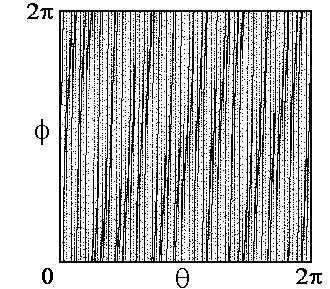 Namely, a curve C wrapping the torus along parallel
transforms under the transformation to a curve C' wrapping the torus
moth along both parallel and meridian.
Each next iteration of the map is accompanied by increase of
a number of the meridian rounds by one, and it tends to infinity
in the limit of large number of steps.
In presence of inhomogeneity due to the nonlinear term in the first equation
it implies fractal nature of distribution of the invariant measure on the attractor.
Portrait of the attractor on the plane of variables
q, f
at F(q,
f)=hsinf, h=0.3 and
Namely, a curve C wrapping the torus along parallel
transforms under the transformation to a curve C' wrapping the torus
moth along both parallel and meridian.
Each next iteration of the map is accompanied by increase of
a number of the meridian rounds by one, and it tends to infinity
in the limit of large number of steps.
In presence of inhomogeneity due to the nonlinear term in the first equation
it implies fractal nature of distribution of the invariant measure on the attractor.
Portrait of the attractor on the plane of variables
q, f
at F(q,
f)=hsinf, h=0.3 and
Let us turn now to the problem of actualization of the SNA of Hant and Ott in a physical system. We consider a system of two coupled non-autonomous van der Pol oscillators with quasiperiodic driving:

Note that the characteristic frequency of the second oscillator is twice larger than that
of the first one.
Parameter responsible for the Andronov - Hopf bifurcation in the autonomous
subsystems is slowly modulated in time. The period T
is assumed to be integer in units of the oscillation period of the individual oscillator.
On one half-period of the modulation the first oscillator is in generation regime,
and te second is below the generation threshold; on the second half period vise versa.
The first oscillator effects the partner via a a term represented by product
of the dynamical variable x and of auxiliary signal at frequency equal to
the characteristic frequency of the first oscillator.
Generated second harmonic component is resonance for the second oscillator and serves as
priming at the passage of it to the excitation stage.
In turn, the second oscillator acts upon the first one via a product od
the variable y and the auxiliary signal with frequency being in
an irrational ratio with the characteristic frequency of the oscillator.
w.
A difference frequency component arising serves as priming for
the first oscillator as it starts to generate again.
The oscillatory regime in the system corresponds
to alternating transfer of the excitation from one oscillator to another.
The picture shows time dependence of the variables
x and y at parameter values

Let us assume that the first oscillator on a stage of generation
has some phase j:
x~sin(2pt+j).
In a product of it with the auxiliary signal

which may be rewritten precisely in the form suggested by Hunt and Ott at F=0 by means of
the variable change j to
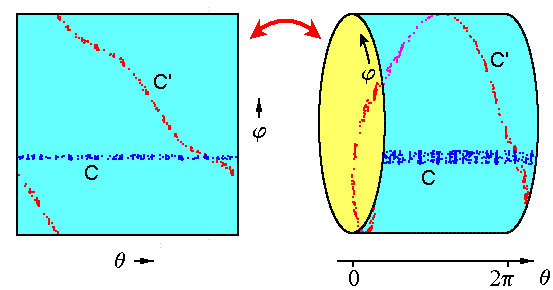
In fact, the phase space of our system is six-dimensional. Indeed, to define an instantaneous state, we have to indicate the values x and y, respective time derivatives dx/dt and dy/dt, time t in an interval corresponding to one modulation period, and a phase of the external driving on the incommensurate frequency q. In terms of stroboscopic Poincare section, considering a sequence of states following with the period T, we get a 5D map. One variable, the phase q has a special role as it obeys an equation, which does not depend on other variables. The map is of such nature that a strong contraction takes place over all the variables beside of two of them. They just correspond to the phase of oscillations and the phase of driving on the incommensurate frequency.
The next figure shows a stroboscopic portrait of SNA on the state plane of the first oscillator
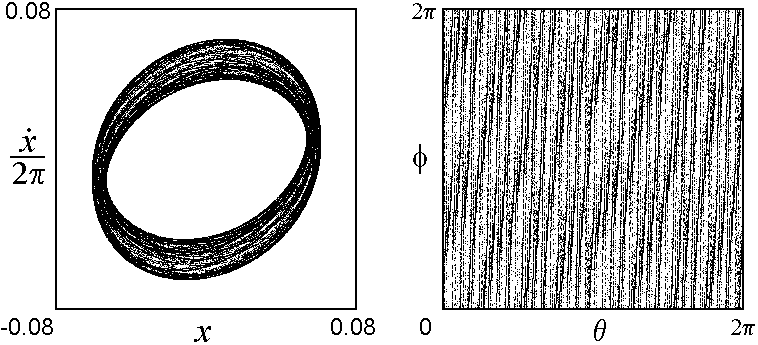
The second picture manifests an obvious similarity to the portrait of the attractor for the mapping of Hunt and Ott. It is possible to construct more accurately the model of Hunt and Ott type for our system. For this, we have to determine a function F(q, f). Accounting the periodicity condition, it may be represented as a Fourier series over two arguments. The coefficients of the expansion are expressed via respective integrals over a period of the phase variables. Performing computations and tracing the stroboscopic sequence qn, fn, we accumulate a sufficiently long series Fn= fn+1-fn -qn, we use it for estimate of the integrals by means of the Monte-Carlo method. It appears that the coefficients of the first and of the third order vanish. Retain terms of zero and second order we obtain for the desired function

The left diagram shows a 3D plot of the function from the computational solution of the equations, and the right one represents the approximating function
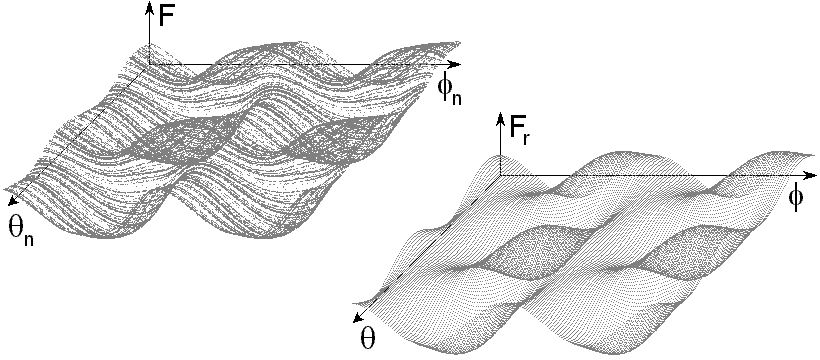
In accordance with numerical estimates, the largest nontrivial Lyapunov exponent for the attractor (with time normalized by a period
of modulation) equals
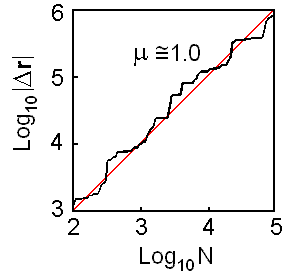 One more traditional characteristic of SNA is the phase sensitivity exponent PSE
(see a page devoted to quantitative characteristics of SNAs).
To estimate PSE, we perform numerical solution of the equations for the coupled non-autonomous
oscillators and of equations for a perturbed orbit, which differs with a small shift of
the phase of the driving on the incommensurate frequency q0.
The PSE determines the growth of the maximal observed deflection for the perturbed orbit from the
original one in dependence on the observation time NT, namely,
|Dr|~Nm.
In the double logarithmic scale we plot the value of the maximal observed deflection on the
observation time (the left diagram).
Approximating this dependence with a strait line, we get
PSE as an angle coefficient of the line. In the present case,
m=1.0. (Not that for a torus-attractor we would have
m=0.)
One more traditional characteristic of SNA is the phase sensitivity exponent PSE
(see a page devoted to quantitative characteristics of SNAs).
To estimate PSE, we perform numerical solution of the equations for the coupled non-autonomous
oscillators and of equations for a perturbed orbit, which differs with a small shift of
the phase of the driving on the incommensurate frequency q0.
The PSE determines the growth of the maximal observed deflection for the perturbed orbit from the
original one in dependence on the observation time NT, namely,
|Dr|~Nm.
In the double logarithmic scale we plot the value of the maximal observed deflection on the
observation time (the left diagram).
Approximating this dependence with a strait line, we get
PSE as an angle coefficient of the line. In the present case,
m=1.0. (Not that for a torus-attractor we would have
m=0.)
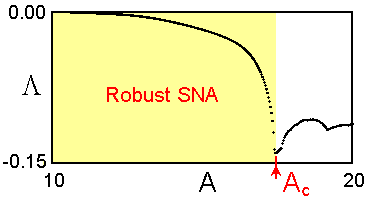 The robust strange nonchaotic attractor occurs in a wide
parameter range. The diagram to the right sows the largest nontrivial Lyapunov exponent
versus A at T=6, e=0.6.
The topological properties of the phase mapping remain unchanged in an interval 0<A<Ac,
where the robust SNA just takes place.
Observe from the picture a change of character of dependence of the Lyapunov exponent
with decrease of A: in the domain of robust SNA the curve becomes smooth.
The robust strange nonchaotic attractor occurs in a wide
parameter range. The diagram to the right sows the largest nontrivial Lyapunov exponent
versus A at T=6, e=0.6.
The topological properties of the phase mapping remain unchanged in an interval 0<A<Ac,
where the robust SNA just takes place.
Observe from the picture a change of character of dependence of the Lyapunov exponent
with decrease of A: in the domain of robust SNA the curve becomes smooth.